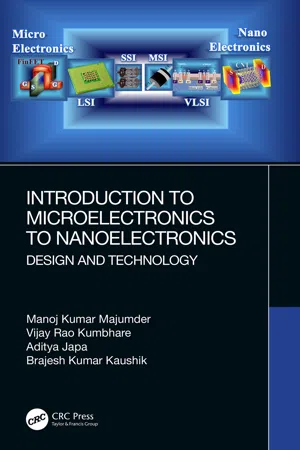
Introduction to Microelectronics to Nanoelectronics
Design and Technology
- 328 pages
- English
- ePUB (mobile friendly)
- Available on iOS & Android
Introduction to Microelectronics to Nanoelectronics
Design and Technology
About this book
Focussing on micro- and nanoelectronics design and technology, this book provides thorough analysis and demonstration, starting from semiconductor devices to VLSI fabrication, designing (analog and digital), on-chip interconnect modeling culminating with emerging non-silicon/ nano devices. It gives detailed description of both theoretical as well as industry standard HSPICE, Verilog, Cadence simulation based real-time modeling approach with focus on fabrication of bulk and nano-devices. Each chapter of this proposed title starts with a brief introduction of the presented topic and ends with a summary indicating the futuristic aspect including practice questions. Aimed at researchers and senior undergraduate/graduate students in electrical and electronics engineering, microelectronics, nanoelectronics and nanotechnology, this book:
- Provides broad and comprehensive coverage from Microelectronics to Nanoelectronics including design in analog and digital electronics.
- Includes HDL, and VLSI design going into the nanoelectronics arena.
- Discusses devices, circuit analysis, design methodology, and real-time simulation based on industry standard HSPICE tool.
- Explores emerging devices such as FinFETs, Tunnel FETs (TFETs) and CNTFETs including their circuit co-designing.
- Covers real time illustration using industry standard Verilog, Cadence and Synopsys simulations.
Frequently asked questions
- Essential is ideal for learners and professionals who enjoy exploring a wide range of subjects. Access the Essential Library with 800,000+ trusted titles and best-sellers across business, personal growth, and the humanities. Includes unlimited reading time and Standard Read Aloud voice.
- Complete: Perfect for advanced learners and researchers needing full, unrestricted access. Unlock 1.4M+ books across hundreds of subjects, including academic and specialized titles. The Complete Plan also includes advanced features like Premium Read Aloud and Research Assistant.
Please note we cannot support devices running on iOS 13 and Android 7 or earlier. Learn more about using the app.
Information
1 Semiconductor Physics and Devices
1.1 Introduction
1.1.1 Conduction in Solids


1.1.2 Conductors, Insulators, and Semiconductors
1.1.2.1 Conductors
- Conductors have high electrical and thermal conductivities.
- In steady states, they obey Ohm’s law.
- They have a positive temperature coefficient, i.e., their resistance increases with an increase in temperature.
- They obey Wiedemann–Franz law, according to which the ratio of thermal and electrical c...
Table of contents
- Cover
- Half Title
- Title Page
- Copyright Page
- Contents
- List of Figures
- List of Tables
- List of Abbreviations
- Preface
- Authors
- Acknowledgments
- Chapter 1 Semiconductor Physics and Devices
- Chapter 2 VLSI Scaling and Fabrication
- Chapter 3 MOSFET Modeling
- Chapter 4 Combinational and Sequential Design in CMOS
- Chapter 5 Analog Circuit Design
- Chapter 6 Digital Design Through Verilog HDL
- Chapter 7 VLSI Interconnect and Implementation
- Chapter 8 VLSI Design and Testability
- Chapter 9 Nanomaterials and Applications
- Chapter 10 Nanoscale Transistors
- MCQ Answers
- Index